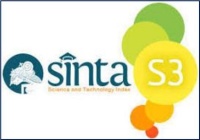Kandungan Gizi Makro Kerupuk Daun Kelor (Moringa oleifera) Sebagai Inovasi Cemilan Bergizi
Abstract
This study aims to determine the amount of macronutrient content contained in Moringa leaf crackers (Moringa oleifera). This study used a Complete Random Design (RAL) and was an experimental study using moringa leaf flour formulations, namely F0 (0%), F1 (10%), F2 (15%), and F (20%) each treatment was repeated 3 times. The analysis data with the Analysis Of Variance (ANOVA) statistical test showed the real difference between treatments. Determination of protein content using the Anthrone method, protein content using the Biuret method, and determination of fat content using Soxhlet. The results showed that the carbohydrate content in the formula of 10% moringa leaf flour was 0.47%, the formula of 15% moringa leaf flour was 0.41%, the formula of 20% moringa leaf flour was 0.34%, the protein content in the formula of 10% moringa leaf flour was 0.262%, the formula of 15% moringa leaf flour was 0.313%, and the formula of 20% moringa leaf flour was 0.322%. The fat content in the 10% moringa leaf flour formula is 10.28%, the 15% moringa leaf flour formula is 13.76% and the 20% moringa leaf flour formula is 28.26%.
Keywords
Full Text:
PDFReferences
Astutik, A.D., Maflahah, I., & Rakhmawati. (2019). Analisis preferensi konsumen terhadap garam fortifikasi kelor. Jurnal Sosial Ekonomi dan Pertanian, 8(2), 117-127.
Augustyn, G.H., Tuhumury, H.C.D., & Dahoklory, M. (2017). Pengaruh penambahan tepung daun kelor (Moringa oleifera) terhadap karakteristik organoleptik dan kimia biskuit Mocaf. AGRITEKNO: Jurnal Teknologi Pertanian, 6(2), 52-58.
Cahyani, P. M., Maretha, D. E., & Asnilawati, A. (2020). Uji kandungan protein, karbohidrat dan lemak pada larva maggot (Hermetia Illucens) yang di produksi di kalidoni kota palembang dan sumbangsihnya pada materi insecta di kelas X Sma/Ma. Bioilmi: Jurnal Pendidikan, 6(2), 120-128.
Dima, E.T.Y., & Waja, M.A.P.S. (2022). Peran UMKM Dalam Menjaga Stabilitas Perekonomian Masyarakat Akibat Pandemi Covid-19 di Kota Atambua Kabupaten Belu (Studi Kasus Home Industri Pembuatan STIK Berbahan Dasar Daun Kelor). Jurnal Pengabdian Masyarakat, 5(10), 9-13.
Gillespie, J. 2021. “You are what You eat”: The Roleof Dietary Macronutrients and Micronutrients in MaFlD. Clinical Liver Disease,18(2), 67.
Hekmat, S., Morgan, K., Soltani, M., & Gough, R. (2015). Sensory evaluation of locallygrown fruit purees and inulin fibre on probiotic yogurt in Mwanza, Tanzania and the microbial analysis of probiotic yogurt fortified with Moringa oleifera. J. Health Popul. Nutr., 33(1), 60-67.
Irwan, Z. (2020). Kandungan Zat Gizi Daun Kelor (Moringa oleifera) berdasarkan Metode Pengeringan. Jurnal: Jurnal Kesehatan Manarang.
Jonni, MS. 2008. Cegah Malnutrisi dengan Kelor. Yogyakarta: Kanisius.
Kou, X., Li, B., Olayanju, J.B., Drake, J.M., & Chen, N. (2018). Nutraceutical or Pharmacological Potential of Moringa oleifera Lam. Nutrients, 10(343), 1-12.
Krisnadi, A. D. (2015). Kelor Super Nutrisi. Jawa Tengah: Kelorina.com.
Kristina, N. N., & Siti, F. S. (2014). Pemanfaatan Tanaman Kelor (Moringa oleifera) Untuk Meningkatkan Produksi Air Susu Ibu. Warta Penelitian dan Pengembangan Tanaman Industri, 20(3), 26-29.
Leone, A., Spada, A., Battezzati, A., Schiraldi, A., Aristil, J., & Bertoli, S. (2015). Cultivation, genetic, ethnopharmacology, phytochemistry, and pharmacology of Moringa oleifera leaves: An overview. International Journal of Molecular Sciences, 16(6), 12791-12835.
Muchsiri, M., Idealistuti & Rizal Ambiyah. 2020. Penambahan Tepung Daun Kelor Pada Pembuatan Kerupuk Ikan Sepat Siam. Jurnal Edible. 7(1): 49-63
Nadirah, S. (2019). Analisa kandungan lemak, protein dan organoleptik ilabulo hati dan ampela ayam. Gorontalo Agriculture Technology Journal, 2(1), 1-9.
Nugraha, Aditya. 2013. Bioaktivitas Ekstrak Daun Kelor (Moringa oleifera) terhadap Eschericia coli penyebab Kolibasilosis. Thesis. Denpasar: Fakultas Kedokteran Hewan, Universitas Udayana.
Pojoh, A. R., Malonda, N. S., & Punuh, M. I. (2023). Gambaran Asupan Zat Gizi Makro pada Remaja Putri di Kelurahan Paslaten Kecamatan Tomohon Timur Kota Tomohon. Jurnal Lentera Sehat Indonesia, 2(1), 01-06.
Qalsum.(2015). Analisis kadar Karbohidrat,Lemak, dan Protein dari Tepumg Biji Mangga (Magifera indica L). Pendidikan Kimia Fkip Universitas Tadulako.Palu.
Ruchdiansyah, D., & Amalia, L. (2016). Formulasi Kerupuk Dengan Penambahan Daun Kelor (Moringa oleifera). Jurnal Pertanian, 7(2).
Santoso, B. B & I. G. M. A. Panrata. (2018). Biji dan Teknologi Benih Kelor (Moringa oleifera Lam). Mataram: Arga Puji.
Sari, S. R., & Pratama, W. (2020). Analisis Potensi Ekspor Kerupuk dari Indonesia. Jurnal Manajemen Pemasaran, 12(4), 200-214.
Setyaningsih, E., Purwani, E., & Sabrin (2019). Kandungan Gizi dan Mutu Protein Tepung Biji Kelor Terfermentasi. Jurnal Teknol, dan Industri Pangan, 30(20).
Syarifah, A. (2015). Kandungan Nutrisi dan Sifat Fungsional Tanaman Kelor (Moringa oleifera). Jurnal Balai Pengkajian Teknologi Pertanian, 5(2).
Valdivié-Navarro, M., Martinez-Aguilar, Y., Mesa-Fleitas, O., Botello-Leon, A., Betancur Hurtado, C., & VelazquezMarti, B. (2020). Review of Moringa oleifera as forage meal (leaves plus stems) intended for the feeding of nonruminant animals. Animal Feed Science and Technology, 260(2), 114338.
Wahyuni, D. (2013) Uji Pengaruh Penambahan Tepung Daun Kelor Pada Kerupuk Tongkol. Jurnal Industri Pangan, 7(3).
Zakaria, A. T. 2012. Penambahan tepung daun kelor pada menu makanan sehari –hari dalam Upaya penanggulangan gizi kurang pada anak balita. Media Gizi Pangan, 8(190).
DOI: https://doi.org/10.33394/bioscientist.v13i2.16564
Refbacks
- There are currently no refbacks.

This work is licensed under a Creative Commons Attribution-ShareAlike 4.0 International License.

Bioscientist : Jurnal Ilmiah Biologi is licensed under a Creative Commons Attribution-ShareAlike 4.0 International License
Editorial Address: Pemuda Street No. 59A, Catur Building Floor I, Mataram City, West Nusa Tenggara Province, Indonesia











